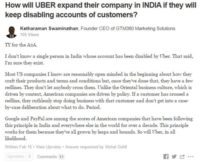Many people have reacted vehemently against the government’s move to regulate the creation, distribution and usage of Indian maps under the proposed Geospatial Information Regulation bill.
Some have even insinuated that the move is a veiled threat to police Google Maps and amounts to “throwing out the baby with the bathwater”.
I don’t know whether they’re right or wrong in the specific context of mapping but throwing the baby out with the bathwater is a fairly common practice in many contexts in India. Let me cite two recent examples of the practice:
- 2% of online credit card transactions are reported to be fraudulent. When the regulator discovers this, it responds with its mandate for two factor authentication for all online payments, ostensibly to secure online payments and encourage more people to pay online. But something else happens: 2FA introduces a lot of friction in the online payment journey and results in a high percentage of failed payments, which puts off 100% of consumers who were previously paying online. Many of them – including me – turn to cash. Cash becomes king – even in ecommerce.
70% COD in ecommerce is even higher than widely believed – or has the %age gone up in recent times? pic.twitter.com/kDqBr3Ev72
— GTM360 (@GTM360) June 6, 2016
- A call center rep of a telecom company answers a caller’s question about his native place. Soon enough the company spots this transgression of company policy – the “calls are recorded for audit and training purposes” is not idle warning! But it doesn’t reprimand the said CSR. Instead, the shift manager makes a public announcement over the P.A system reiterating company policy forbidding CSRs from sharing personal information with customers. All 500 CSRs in the floor hear it. The offending CSR is not sure whether the company was referring to him at all or merely reiterating company policy. The other 499 CSRs waste the next two hours speculating which one of their colleagues did what to trigger the announcement.
So throwing the baby out with the bathwater is almost the practice du jour in policy-making and happens often even in the corporate world.
It’s not good for business. World-class companies don’t do it.
Google once found that many website owners hosting its online ads via its AdSense program were clicking on many ads by themselves. At peak, 12-15% of all ad clicks were fraudulent. Such a high percentage of click fraud severely undermined the credibility of Google’s AdWords platform. Did Google discontinue AdSense? No. For a company that earns nearly 90% of its revenues from ads, that’d be harakiri.
Uber has a popular referral program where you can earn a free ride every time the person referred by you takes a ride. In the early days, many people used to game the system by creating multiple accounts so that they could claim the reward multiple times. Surely this went against the spirit of the referral program. Did Uber withdraw the program? No. That would’ve stymied its growth in the early stages.
Google and Uber took a nuanced approach to combat their existential threats.
Google used sophisticated fraud detection technology to ferret out heavy perpetrators of click fraud. Without any warning, Google blacklisted their AdSense accounts. While the affected website owners accused Google of behaving autocratically, the company did contain click fraud and manage to restore advertisers’ confidence in AdWords.
 Once it achieved a critical mass of adoption, Uber turned its attention to the miscreants who were gaming its system. Using technology to detect multiple accounts originating from the same handset, the company canceled the accounts of hundreds of people. Like Google, Uber didn’t issue any warning. But people got the message and learned not to fool around with Uber. Uber grew from strength to strength.
Once it achieved a critical mass of adoption, Uber turned its attention to the miscreants who were gaming its system. Using technology to detect multiple accounts originating from the same handset, the company canceled the accounts of hundreds of people. Like Google, Uber didn’t issue any warning. But people got the message and learned not to fool around with Uber. Uber grew from strength to strength.
Thus Google and Uber devised sophisticated ways to safeguard their business without killing them off prematurely.
Hope Indian regulators and corporates learn a lesson from these two global powerhouses on how to take a nuanced approach towards policy making and implementation.
I also see a parallel between this topic and my favorite subject of spam versus targeted offers. With a little imagination, product owners should be able to use the learnings from the above examples to spec their product features in such a way that their customers get a better CX instead of becoming the baby that gets thrown out with the bathwater!


